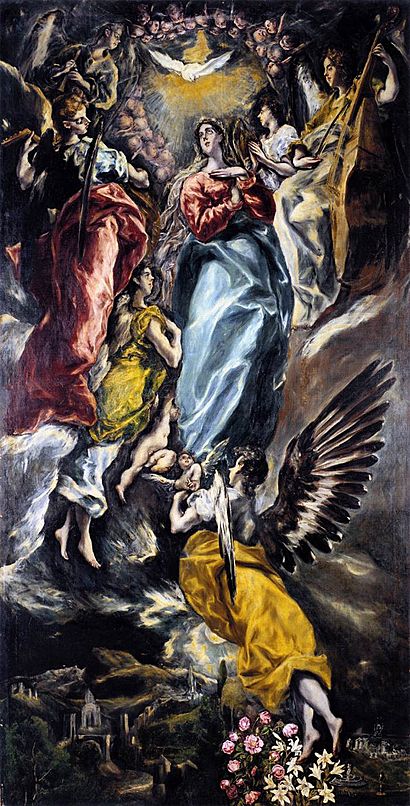The Immaculate Conception (El Greco, Toledo) facts for kids
Quick facts for kids The Immaculate Conception |
|
|---|---|
 |
|
| Artist | El Greco |
| Year | 1607–1613 |
| Medium | Oil on canvas |
| Dimensions | 348 cm × 174.5 cm (137 in × 68.7 in) |
| Location | El Greco Museum, Toledo, Toledo, Spain |
The Virgin of the Immaculate Conception is a famous painting by the artist El Greco. He started working on it in 1607 and finished it in 1613. This painting belongs to the church of San Nicolás de Bari in Toledo, Spain. However, you can see it displayed at the El Greco Museum, Toledo.
Contents
El Greco's Artistic Journey
El Greco learned a lot about art during his time in Venice and Rome, Italy. He explored different ways of painting, focusing on either color (colore) or drawing (disegno). In 1577, El Greco moved to Toledo. This move was very important for his role in the Spanish Renaissance art movement.
Moving to Toledo
In Italy, El Greco was part of a group of artists and thinkers. They believed that a true artist, or virtuoso, used their imagination beyond just basic skills. However, this idea was not as common in Toledo, Spain.
El Greco hoped to become a well-known artist in Spain. He wanted to get the support of King Phillip II. Royal support would have helped him settle in Spain. It might even have helped him move to a big city like Madrid. But El Greco had some disagreements about how much he was paid for his work. Because of this, King Phillip did not approve of his art.
Life and Success in Toledo
El Greco stayed in Toledo for the rest of his life. He was well-liked by other artists and writers there. One friend, a poet named Hortensio Félix Paravicino, wrote about him. He said that Crete gave El Greco life, but Toledo gave him a better home.
El Greco became very successful in Toledo. Between 1581 and 1585, many people wanted him to create religious paintings. His customers could choose from smaller examples of his work. Then, he would change them to fit their wishes.
Later, El Greco ran his own workshop. This workshop created frames and structures for cathedrals. The years from 1597 to 1607 were very good for him. He received many important projects. Even though he stayed in Toledo, these projects helped him become a very famous artist.
El Greco's Unique Style
El Greco believed that color was more important than the shape or form in a painting. This idea came from his training in Venice. His later paintings show figures that look more dramatic than realistic. He was able to show deep feelings without being overly emotional.
Elongated Figures
El Greco often made his figures look long and stretched out. This is very clear in his large altarpiece paintings. For The Virgin of the Immaculate Conception, El Greco even asked for the altarpiece to be made longer. He did this so the Virgin Mary's figure would not look too short.
Influence on Modern Art
Even though some people criticized El Greco's style, his art inspired many artists later on. In the 19th century, artists like Eugène Delacroix and Édouard Manet admired his use of color and expression.
His way of blending space and figures also influenced artists in the 20th century. Modern artists like Paul Cézanne and Pablo Picasso used similar ideas. Because of this, El Greco is seen as a very early influence on art styles like Expressionism and Cubism.
Artists who were part of the symbolists movement were also inspired by El Greco. They liked how he showed calm, deep feelings in his paintings. Writers like Rainer Maria Rilke and Nikos Kazantzakis were also moved by El Greco's art. Rilke even wrote poems after seeing The Virgin of the Immaculate Conception. Today, artists like Kysa Johnson still use El Greco's works as inspiration for their own art.
Images for kids
See also
 In Spanish: Inmaculada Concepción (Capilla Oballe, El Greco) para niños
In Spanish: Inmaculada Concepción (Capilla Oballe, El Greco) para niños



